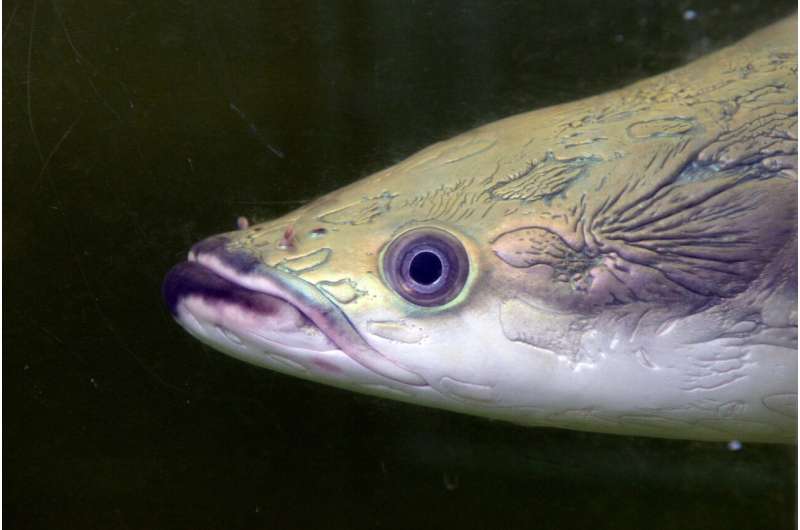Large aquatic animals are at risk due to the loss of free-flowing rivers

The loss of free-flowing rivers has posed advert impacts on freshwater biodiversity worldwide—and more than 3,400 hydropower plants with over one megawatt design capacity are either planned or under construction, leading to further reduced river connectivity. A study led by researchers at the Leibniz Institute of Freshwater Ecology and Inland Fisheries (IGB) shows: if all the proposed dams were built, 19 percent of free-flowing rivers that are longer than 500 km and inhabited by freshwater megafauna will lose their free-flowing status. The study also finds that freshwater megafauna diversity is higher in future fragmented free-flowing rivers than in rivers that would remain free-flowing in the future or that are already fragmented.
Human activities including dam constructions and building levees, roads, and houses along rivers and in floodplains have led to the loss of free-flowing rivers. Due to thousands of proposed hydropower dams, further loss of free-flowing rivers is expected. This also means that intact aquatic habitats are declining—especially for freshwater megafauna, animals that can reach a body mass of 30 kg and more. "Indeed, freshwater megafauna with a short accumulated length of free-flowing rivers in their distribution ranges are more likely to be threatened", said IGB researcher Dr. Fengzhi He, lead author of the study.
The study, published today in the journal Biological Conservation, involved the IGB, WWF, McGill University, University of Nevada, Reno, University of Tübingen and Senckenberg Nature Research Society.
Proposed dams: Megafauna-rich rivers are particularly affected
The researchers investigated how the global patterns of river connectivity within distribution ranges of freshwater megafauna could change in the future. If all proposed dams were built, over 600 free-flowing rivers with a length over 100 km will be fragmented. The average number of freshwater megafauna taxa in future fragmented free-flowing rivers is higher than in rivers that are currently not free-flowing or remaining free-flowing in the future. Free-flowing rivers over 500 km long will be particularly affected, with 19 percent of them at risk of losing their free-flowing status. Over 260 new dams will then fragment 75 major rivers such as the Amazon, Congo, Salween, and Irrawaddy.
These dams will block movement pathways of freshwater megafauna and could lead to reduced reproduction and genetic isolation. "Freshwater megafauna often have complex habitat requirements and life histories adapted to natural flow regime and require movement between habitats to complete their life cycles. For example, most sturgeon species migrate from the ocean to rivers for spawning. The connections between the ocean and their spawning grounds in freshwaters are therefore essential for their survival. Other large fish species such as the Mekong giant catfish, Pangasianodon gigas, and dourada, Brachyplatystoma rousseauxii, migrate long distance within freshwaters to reproduce. Therefore, they are particularly vulnerable to reduced river connectivity." explained Dr. Fengzhi He.
Reduced river connectivity will also affect non-fish species
Apart from migratory fish, other freshwater megafauna species including river dolphins, crocodilians, turtles, and giant salamanders are also susceptible to reduced river connectivity. "Dams have caused serious habitat fragmentation and degradation for Gharials, Gavialis gangeticus and have detrimental effects on these river-dwelling animals", said Dr. Fengzhi He, "Roads, buildings, and other infrastructure along the rivers reduce lateral connectivity between rivers and riparian areas, leading to habitat loss and increased mortality for crocodilians and turtles".
"The study illustrates the potential impacts of reduced river connectivity on freshwater biodiversity. It is important to assess the trade-offs between ecosystem integrity and economic development of the regions prior to dam construction. Strategic planning of hydropower plants helps avoid disproportionate impacts of individual plants on freshwater ecosystems, for example, potential impacts on biodiversity, particularly on threatened and susceptible species. More studies are needed to help strategic dam siting, design, and operation that are as environmentally sound as possible. For example, we need to identify critical habitats for species and know more about their life histories", summed up Prof. Sonja Jähnig from IGB and Humboldt Universität zu Berlin, who is the senior author of the study.
More information: Impacts of loss of free-flowing rivers on global freshwater megafauna. Biological Conservation, Volume 263, 2021, 109335, ISSN 0006-3207 doi.org/10.1016/j.biocon.2021.109335
Journal information: Biological Conservation
Provided by Forschungsverbund Berlin e.V. (FVB)




















